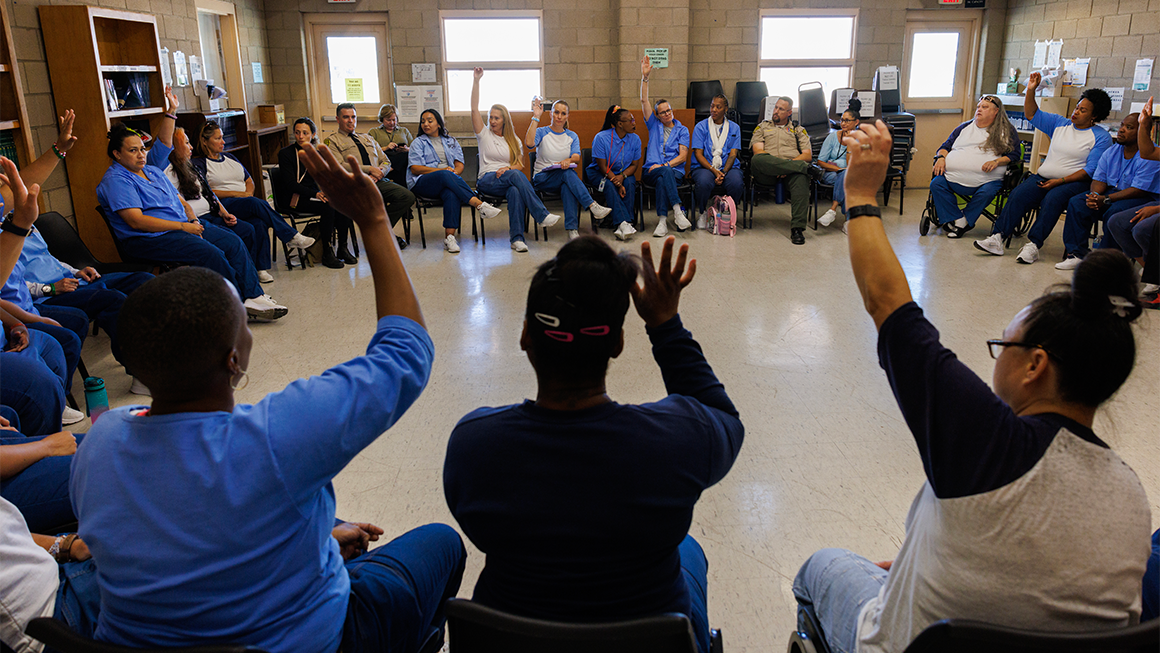
Prisons are managed hierarchically: Department of corrections directors and secretaries oversee all state prisons, wardens serve as chief executive officers of individual prisons, and prison staff, such as associate wardens and facilities’ managers, report to wardens. This strict chain of command and the many levels between upper management and day-to-day operations means that the people who work and are incarcerated in prisons—who have the most experience within the system—often do not have a say in how prisons are run.
In 2019, the Urban Institute launched the Prison Research and Innovation Initiative (PRII) to challenge this model. PRII’s goal was straightforward: to encourage prisons to open themselves to participatory research, where people directly affected by a problem help shape the questions, process, and solutions.
PRII was predicated on the idea that community engagement creates the most effective solutions and that prisons improve when they invite researchers to work with them to identify challenges, cocreate innovations, and establish systems to track and evaluate progress.
But how would this theory and approach work in an environment that doesn’t always facilitate it? The Urban Institute identified a network of researchers and prisons in five states that would carry out the community-engaged approach at the heart of PRII’s mission. Alongside the research conducted locally in each facility, Urban executed a process study to understand whether PRII’s approach was rolled out as designed. We found that participatory methods were successful in many ways and across several of our pilot prisons.
Here are six lessons we learned about conducting participatory research in prisons to create meaningful innovations and reforms.
- Leadership buy-in is crucial, ongoing, and multifaceted.
Participatory research in corrections facilities requires an intentional, agency-wide strategy. Success hinges on continuous buy-in that reaches commissioners, wardens, line and nonsecurity staff, and incarcerated people, because each group shapes institutional culture and can either advance or block reform.
PRII shows that sustained change depends on meaningfully engaging line-level employees, whose daily routines can make or break innovations. Middle management is also important, and facility leadership warrants special attention as a distinct stakeholder group. Treating wardens and midlevel managers as coresearchers fosters collaboration. Because leadership in corrections changes often, the process must restart each time a new commissioner or warden takes over. - Expect and counteract an us-versus-them mindset.
Researchers must prepare for entrenched us-versus-them attitudes: Staff may view benefits for incarcerated people (e.g., expanded contact visits) as security risks, whereas incarcerated people may see staff-centered improvements (e.g., revamped lounges) as inequitable. Recognizing and openly addressing these zero-sum perceptions is essential, particularly in a resource-stretched environment like corrections.
Identifying benefits that are cost-effective and feasible within budget constraints can be difficult, particularly when participatory methods encourage groups to be imaginative about change in ways that may not be possible. Giving equal attention to the two groups and consistently communicating that is important. - Identify a project champion.
The project champion in Missouri had experience in both corrections and working for a chamber of commerce, where she mastered the art of working with businesses and community members alike. She brought this mindset to her role in the prison, engaging directly with staff and incarcerated people daily and keeping a positive attitude throughout. - Methodological choices matter.
Mixing concise surveys with interviews and focus groups reduces fatigue while capturing richer context. Because corrections agencies are experiencing historic staffing shortages (PDF), research activities must also minimize burden: Brief surveys, facility wide “walkabouts,” flexible scheduling, and robust protections against retaliation all help staff and incarcerated people feel safe and able to participate. - Pair data collection with early wins.
There is a lot of “low-hanging fruit” that incarcerated people and staff would love to see improved: updated training modules for security staff and better communication about grievance processes. These changes aren’t expensive, don’t create security threats, and don’t require physical plant changes. They are nonetheless meaningful to the staff and incarcerated people who ask for them, and making them happen builds trust and encourages continued engagement. Researchers should deliberately publicize these gains, so stakeholders see concrete improvements that result from their participation. - Lasting reform often requires coordination beyond the prison walls.
Partnering with state policymakers, community service providers, and other justice actors can help departments of corrections overcome budgetary limits, procurement constraints, and statutory barriers. Participants consistently emphasized the value of scaling the model by extending it to additional facilities and states while preserving clear goals and measurement standards. Broadening the network in this way could foster comparative learning, amplify successful practices, and embed participatory, data-driven change across corrections.
A common theme across these lessons is trust. Corrections is an enterprise that tends to be skeptical toward outsiders, so researchers and policy advocates must work to build their trust. We found that some of the most successful pilot prisons were those in which the department of corrections had collaborated with the research partners on several projects over time. Even where partnerships are new, attention to prison dynamics and interpersonal relationships tend to go a long way toward the success of a participatory approach.
Participatory research in prisons is not just a new way to conduct studies. When done thoughtfully and collaboratively, it can create a pathway to concrete, meaningful reform that improves outcomes for everyone working and incarcerated in prisons.
Let’s build a future where everyone, everywhere has the opportunity and power to thrive
Urban is more determined than ever to partner with changemakers to unlock opportunities that give people across the country a fair shot at reaching their fullest potential. Invest in Urban to power this type of work.